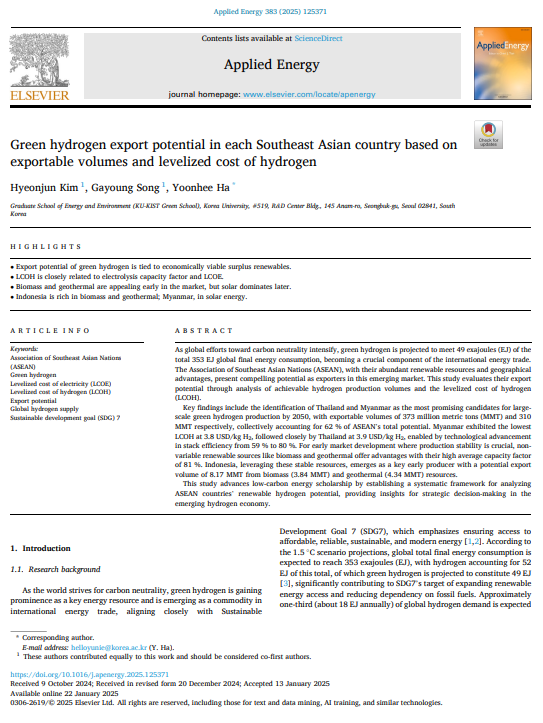
Keyword(s)
Author(s)
Hyeonjun Kim, Gayoung Song, Yoonhee Ha
Country(ies)
Publisher
Published Date
Access
DOI
Graduate School of Energy and Environment (KU-KIST Green School), Korea University, #519, R&D Center Bldg., 145 Anam-ro, Seongbuk-gu, Seoul 02841, South Korea
As global efforts toward carbon neutrality intensify, green hydrogen is projected to meet 49 exajoules (EJ) of the total 353 EJ global final energy consumption, becoming a crucial component of the international energy trade. The Association of Southeast Asian Nations (ASEAN), with their abundant renewable resources and geographical advantages, present compelling potential as exporters in this emerging market. This study evaluates their export potential through analysis of achievable hydrogen production volumes and the levelized cost of hydrogen (LCOH). Key findings include the identification of Thailand and Myanmar as the most promising candidates for large-scale green hydrogen production by 2050, with exportable volumes of 373 million metric tons (MMT) and 310 MMT respectively, collectively accounting for 62 % of ASEAN’s total potential. Myanmar exhibited the lowest LCOH at 3.8 USD/kg H2, followed closely by Thailand at 3.9 USD/kg H2, enabled by technological advancement in stack efficiency from 59 % to 80 %. For early market development where production stability is crucial, non-variable renewable sources like biomass and geothermal offer advantages with their high average capacity factor of 81 %. Indonesia, leveraging these stable resources, emerges as a key early producer with a potential export volume of 8.17 MMT from biomass (3.84 MMT) and geothermal (4.34 MMT) resources. This study advances low-carbon energy scholarship by establishing a systematic framework for analyzing ASEAN countries’ renewable hydrogen potential, providing insights for strategic decision-making in the emerging hydrogen economy.